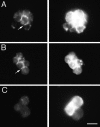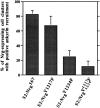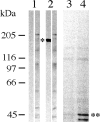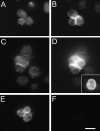Structural requirements for outside-in and inside-out signaling by Drosophila neuroglian, a member of the L1 family of cell adhesion molecules
- PMID: 9660878
- PMCID: PMC2133023
- DOI: 10.1083/jcb.142.1.251
Structural requirements for outside-in and inside-out signaling by Drosophila neuroglian, a member of the L1 family of cell adhesion molecules
Abstract
Expression of the Drosophila cell adhesion molecule neuroglian in S2 cells leads to cell aggregation and the intracellular recruitment of ankyrin to cell contact sites. We localized the region of neuroglian that interacts with ankyrin and investigated the mechanism that limits this interaction to cell contact sites. Yeast two-hybrid analysis and expression of neuroglian deletion constructs in S2 cells identified a conserved 36-amino acid sequence that is required for ankyrin binding. Mutation of a conserved tyrosine residue within this region reduced ankyrin binding and extracellular adhesion. However, residual recruitment of ankyrin by this mutant neuroglian molecule was still limited to cell contacts, indicating that the lack of ankyrin binding at noncontact sites is not caused by tyrosine phosphorylation. A chimeric molecule, in which the extracellular domain of neuroglian was replaced with the corresponding domain from the adhesion molecule fasciclin II, also selectively recruited ankyrin to cell contacts. Thus, outside-in signaling by neuroglian in S2 cells depends on extracellular adhesion, but does not depend on any unique property of its extracellular domain. We propose that the recruitment of ankyrin to cell contact sites depends on a physical rearrangement of neuroglian in response to cell adhesion, and that ankyrin binding plays a reciprocal role in stabilizing the adhesive interaction.
Figures














Similar articles
-
Receptor clustering drives polarized assembly of ankyrin.J Biol Chem. 2000 Sep 8;275(36):27726-32. doi: 10.1074/jbc.M004959200. J Biol Chem. 2000. PMID: 10871626
-
Neuroglian-mediated cell adhesion induces assembly of the membrane skeleton at cell contact sites.J Cell Biol. 1996 May;133(3):647-55. doi: 10.1083/jcb.133.3.647. J Cell Biol. 1996. PMID: 8636238 Free PMC article.
-
The L1-type cell adhesion molecule neuroglian influences the stability of neural ankyrin in the Drosophila embryo but not its axonal localization.J Neurosci. 2000 Jun 15;20(12):4515-23. doi: 10.1523/JNEUROSCI.20-12-04515.2000. J Neurosci. 2000. PMID: 10844021 Free PMC article.
-
The interaction between L1-type proteins and ankyrins--a master switch for L1-type CAM function.Cell Mol Biol Lett. 2009;14(1):57-69. doi: 10.2478/s11658-008-0035-4. Epub 2008 Oct 6. Cell Mol Biol Lett. 2009. PMID: 18839070 Free PMC article. Review.
-
Tenascin-contactin/F11 interactions: a clue for a developmental role?Perspect Dev Neurobiol. 1994;2(1):43-52. Perspect Dev Neurobiol. 1994. PMID: 7530143 Review.
Cited by
-
MAP kinase pathway-dependent phosphorylation of the L1-CAM ankyrin binding site regulates neuronal growth.Mol Biol Cell. 2006 Jun;17(6):2696-706. doi: 10.1091/mbc.e06-01-0090. Epub 2006 Apr 5. Mol Biol Cell. 2006. PMID: 16597699 Free PMC article.
-
Roles of specific membrane lipid domains in EGF receptor activation and cell adhesion molecule stabilization in a developing olfactory system.PLoS One. 2009 Sep 29;4(9):e7222. doi: 10.1371/journal.pone.0007222. PLoS One. 2009. PMID: 19787046 Free PMC article.
-
The L1-type cell adhesion molecule Neuroglian is necessary for maintenance of sensory axon advance in the Drosophila embryo.Neural Dev. 2008 Apr 8;3:10. doi: 10.1186/1749-8104-3-10. Neural Dev. 2008. PMID: 18397531 Free PMC article.
-
Functional binding interaction identified between the axonal CAM L1 and members of the ERM family.J Cell Biol. 2002 Jun 24;157(7):1105-12. doi: 10.1083/jcb.200111076. Epub 2002 Jun 17. J Cell Biol. 2002. PMID: 12070130 Free PMC article.
-
L1CAM/Neuroglian controls the axon-axon interactions establishing layered and lobular mushroom body architecture.J Cell Biol. 2015 Mar 30;208(7):1003-18. doi: 10.1083/jcb.201407131. J Cell Biol. 2015. PMID: 25825519 Free PMC article.
References
-
- Ausubel, F.M., R. Brent, R.E. Kingston, D.D. Moore, J.G. Seidman, J.A. Smith, and K. Struhl. 1988. Current Protocols in Molecular Biology. J. Wiley & Sons, Inc., New York.
-
- Bartel, P.L., C.-t. Chien, R. Sternglanz, and S. Fields. 1993. Using the two- hybrid system to detect protein-protein interactions. In Cellular Interactions in Development: A Practical Approach. D.A. Hartley, editor. IRL Press, Oxford, UK. 153–179.
-
- Bieber, A.J. 1994. Analysis of cellular adhesion in cultured cells. In Drosophila melanogaster: Practical Uses in Cell Biology. L. Goldstein and E. Fyrberg, editors. 44:683–696. Academic Press, San Diego, CA. - PubMed
-
- Bieber AJ, Snow PM, Hortsch M, Patel NH, Jacobs JR, Traquina ZR, Schilling J, Goodman CS. Drosophilaneuroglian: a member of the immunoglobulin superfamily with extensive homology to the vertebrate neural adhesion molecule L1. Cell. 1989;59:447–460. - PubMed
-
- Boulton TG, Nye SH, Robbins DJ, Ip NY, Radziejewska E, Morgenbesser SD, DePinho RA, Panayotatos N, Cobb MH, Yancopoulos GD. ERKs: a family of protein-serine/threonine kinases that are activated and tyrosine phosphorylated in response to insulin and NGF. Cell. 1991;65:663–675. - PubMed
Publication types
MeSH terms
Substances
Grants and funding
LinkOut - more resources
Full Text Sources
Other Literature Sources
Molecular Biology Databases

